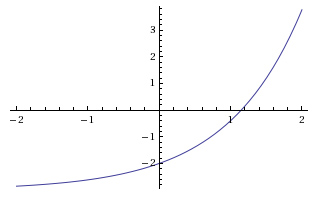
State the domain, range, and horizontal asymptote for the given exponential function: f(x) = [2.6]^x − 3.

| A. |
Domain: (-∞, ∞) Incorrect. The exponential graphs of the form f(x) = a* b^x + c always have a horizontal asymptote. |
| B. |
Domain: (-∞, ∞) Correct! You found the lower range limit and horizontal asymptote even though it wasn’t drawn on the graph. |
| C. |
Domain: (-∞, ∞) Incorrect. The base value of 2.6 doesn’t affect the domain or range in the problem. Focus on the vertical shift of -3 and try again. |
| D. |
Domain: (-2, ∞) Incorrect. Although the picture does not show it, exponential graphs always have an infinite domain. |
Given f(x) = 3*2^(x - 2), state the domain, range, and horizontal asymptote for f(x).
| A. |
Domain: (-∞, ∞) Incorrect. The exponential graphs of the form f(x) = a* b^x + c always have a horizontal asymptote. |
| B. |
Domain: (-∞, ∞) Incorrect. The range is not affected by the base 2. The range can only be affected by a vertical shift, which this function does not have. |
| C. |
Domain: (-∞, ∞) Correct! You found the lower range limit and horizontal asymptote even though it wasn't drawn on the graph. |
| D. |
Domain: (0, ∞) Incorrect. Remember the domain is infinite for exponential functions. |
Given f(x) = [-2 * 3]^(x − 2) + 5, state the domain, range, and horizontal asymptote for f(x).
| A. |
Domain: (-∞, ∞) Correct! You found the proper upper range limit and horizontal asymptote. |
| B. |
Domain: (-∞, ∞) Incorrect. A vertical shift of 5 units causes the horizontal asymptote to shift up 5 units as well. |
| C. |
Domain: (-∞, ∞) Incorrect. Multiplying by -2 turned the exponential function upside down and changed the range. |
| D. |
Domain: (-∞, ∞) Incorrect. A vertical shift of 5 units causes the horizontal asymptote to shift up 5 units as well. Also, multiplying by -2 turned the exponential function upside down and changed the range. |
Given f(x) = 4^(x − 1) + k has a horizontal asymptote at y = 3, what must be the value for k?
|
A. k = -3 |
|
B. k = 1 |
|
C. k = 3 |
|
D. Not enough information |
Given f(x) = a * 2^x - 3 has a range of (-∞, -3), what could be the value of a?
|
A. a = -3 |
|
B. a = 0 |
|
C. a = 2 |
|
D. a = 3 |